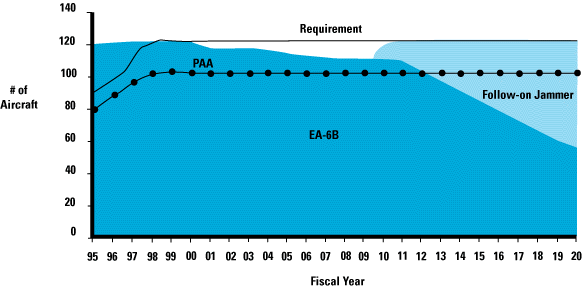- 鐵幣
- 26461 元
- 文章
- 11533 篇
- 聲望
- 11136 枚
- 上次登入
- 19-10-17
- 精華
- 175
- 註冊時間
- 05-12-25
- UID
- 215856
  
|
UpgradesThe EA-6B Block 89A is supposed to IOC in 2000. The upgrade promises to be a substantial improvement over previous Block aircraft.
The communication system is designed around two ARC-210's in the front and one ARC-182 in the back. In addition to being capable of the same communication frequency ranges as the ARC-182, the ARC-210's also have integrated HAVEQUICK and SINCGARS functions.
Another really nice feature about the ARC-210's is that they are integrated with the control display navigation unit (CDNU) so that you can control the radios (all three of them) from a "Radio" page on the CDNU. Navigation system upgrades are also very substantial. The primary navigation sensor is the Litton CN-1649(V)4/ASN-172 Embedded GPS/INS (EGI). This unit combines the Litton LN-100G strapdown inertial unit with a GPS receiver.
The result is that the system, or the aircrew, can select from four possible navigation solutions from this one unit. You can select a pure inertial, GPS, filtered inertial, or filtered inertial solution with GPS aiding. Most of the testing used the filtered inertial solution with GPS aiding, called Blended/Coupled, because it was typically the most accurate.
This mode allowed the Prowler to navigate with an accuracy of about 16 m (52 ft), a big improvement! The ASN-130 is still in the aircraft as the secondary attitude and navigation source with all the capability it has always had. The 89A also features an improved databus structure that allows the CDNU to integrate many things like the radios, RADAR cursor, both navigation sensors, route control, HARM control, WRA BIT, and current navigation and attitude information.
Software improvements to the AGM-88 High-Speed Antiradiation Missile (HARM) have created the Block IIIA and V missile from the Block III and IV hardware. To ensure continued EA-6B compatibility, OFP's SSA 5.2 and 89A 1.0 have been developed by the Weapons System Support Activity, Point Mugu, California. Both are baselined from 5.1 COD, will include HARM III/IIIA/IV/V, and are supported by the same TEAMS release. Two successful live fires of IIIA and V missiles from Block 89A aircraft were made in September 1998 and will be followed this winter by Block 82/89 live fires. The differences in the OFP software will be nearly transparent to the fleet when Block 89A's start arriving. The 89A 1.0 OFP has been optimized for the Block 89A avionics architecture that includes a second 1553 navigation bus and CDNU bus control.
The Multimission Advanced Tactical Terminal (MATT) and Improved Data Modem (IDM), a program originally called the Connectivity Modification, is a miniaturized, airborne UHF receiver providing detection, decryption, and correlation of contact information obtained through the TRAP, TADIXS-B, and TIBS broadcasts. The contact data arrives in near-real-time from national asset sensors and can give an over-the-horizon look at both friendly and hostile platforms and emitters. The MATT is a single WRA installed above the port wing shoulder, with associated satellite receive antenna and filter, replacing the ADF antenna on the 鋳urtleback.
The IDM is a device that formats digital data for transmission using the existing ARC-159, radio No. 3. In a perfect world, incoming MATT data can be examined, selected, and digitally transmitted using the IDM to F-16's as HARM target packages. Information can also be exchanged with other IDM-equipped EA-6B's or Rivet Joint aircraft. The flip side of the new capabilities is that both the MATT and IDM are controlled using a commercially ruggedized laptop computer in a Windows 95 environment, connected by a cable to the center console in the rear cockpit. This less-than-optimum solution of system engineering will be solved when both MATT and IDM systems are integrated into the aircraft displays on the future ICAP III model of the EA-6B.
The USQ-113(V)3 Radio Countermeasures Set, also known as Phase III, was designed to detect, analyze, monitor, and/or jam voice and data link signals. Block 89 has undergone extensive ground testing for the USQ-113, following resumption of testing in September 1998. Ground testing was stopped due to software immaturity and BIT reliability problems. Anechoic chamber testing included finishing electromagnetic compatibility, TEMPEST, precipitation-static, and system performance. Electromagnetic vulnerability testing took place in mid February 1999, and flight testing began at the end of the month. The USQ-113 is controlled primarily by the same ruggedized laptop computer that is used for the MATT/IDM systems, or by an improved operator control panel in the front cockpit.
The EA-6B will begin retirement in the 2010 timeframe, after a career that exceeded 40 years of deployments in support of USN, USMC, and USAF strike forces. As of early 2000, Defense Department planning for replacing the EA-6B Prowler include a scheme under which the Navy would buy an F/A-18G "Growler" -- an F/A-18E/F modified for escort and close-in jamming. The Air Force would provide standoff jamming with modified EB-52s or EB-1s, and close-in jamming with unmanned air vehicles such as the Northrop Grumman Global Hawk or General Atomics Predator.

[ 本文最後由 jacklf2004 於 07-10-7 04:05 PM 編輯 ] |
|
